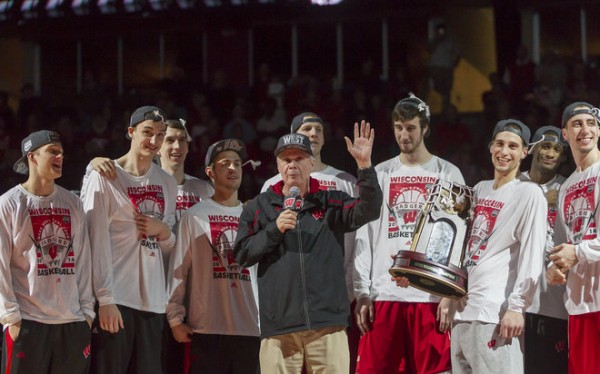Overvaluing Previous Year’s Success in Preseason Rankings
Posted by William Ezekowitz on November 20th, 2015Part of what makes college basketball both exciting and maddening is that each year we have to throw out the previous year’s assumptions and start from scratch. If that wasn’t apparent before this season started, it became painfully obvious when mighty Wisconsin, last year’s national runner-up, lost to Western Illinois, the worst team in last year’s Summit Conference. But perhaps it is the case that we don’t erase the previous year from our memory at the beginning of each season as much as we should. The Badgers, despite retaining just three of the eight players who earned meaningful minutes and bringing in zero top 100 recruits, were still ranked 17th in the preseason polls. In fact, 13 of last year’s Sweet Sixteen teams started the season in the USA Today Preseason Top 25. Can the success of all of these programs be so stable? Or are we perhaps suffering from recency bias, where we tend to overvalue teams that have recently succeeded, even if the personnel structures of those teams have drastically changed?
In order to answer this question, I checked the preseason and postseason USA Today Coaches’ Polls (with postseason being taken after the conclusion of the NCAA Tournament), and checked how many Sweet Sixteen teams from the previous season were in each poll. If we are overvaluing Sweet Sixteen teams, then there would consistently be more teams from the previous year’s Sweet Sixteen in the preseason poll than in the postseason poll, which would indicate that Sweet Sixteen teams have dropped out due to poor performance.
This is exactly what has happened. Going back seven years, the number of previous year’s Sweet Sixteen teams has always been greater in the preseason poll than in the postseason poll. Of 112 possible Sweet Sixteen teams to choose from in those seven years, 77 have appeared in the preseason poll and just 61 have appeared in the postseason poll. A difference of proportions test reveals that these two numbers are significantly different from each other at the 95 percent confidence level, which, in layman’s terms, means that this trend is too strong to write off as pure coincidence.
This analysis, of course, should be taken with a grain of salt. Top 25 polls are relatively arbitrary measures of success, and it doesn’t account for gradations of that success (i.e., in this method, being 25th in the poll counts as much as being first). You would probably want to investigate a bit more before you published it in a scientific paper, but at the same time, the trend is significant and impossible to ignore. The fact is that we do, to some degree, overvalue previous year’s NCAA Tournament success when projecting a team’s strength for a given year.
So what does this mean for the 13 Sweet Sixteen teams that started in this year’s Top 25? For starters, the last time that many teams from the previous year’s Sweet Sixteen began in the preseason Top 25 was two years ago — but only nine ended up there at the end of the year. Moreover, the number of Sweet Sixteen teams from the previous year that ended up in the final Top 25 has never exceeded nine. So if we believe what the last seven years of data is telling us, some of those 13 teams are going to regress this year. Those teams are: Kentucky, West Virginia, Notre Dame, Wichita State, North Carolina, Wisconsin, Arizona, Oklahoma, Michigan State, Duke, Utah and Gonzaga. The Badgers’ inauspicious start has earmarked it as a prime candidate for regression. Wichita State has also already lost a game, albeit on the road and with an ailing Fred Van Vleet. Several other teams are working with nearly completely new rosters.
But any educated guesses about which teams will not be there at the end of this year should probably wait until more evidence is available. Right now, all we have to work with is what we saw happen last year, and, if we have learned anything from this exercise, it’s that we aren’t very good at projecting this year based on what we saw last year. So buckle up for a fun season and prepare to have your expectations shattered on more than one occasion. We aren’t very good at predicting what’s going to happen in a given college basketball season, but that’s exactly what makes following it so great.











































Doesn’t this trend not necessarily mean that we overestimate teams from the previous year, but simply that we’re bad at picking top 25 teams overall. If there is a similar drop for preseason top 25 teams that weren’t successful the previous year, wouldn’t that be an indication that wrongly picking top 25 teams in the preseason isn’t about previous years success, but about overall uncertainties before a single game is played.
[…] in professional sports, weirdly important in college basketball. I have shown in the past that they overvalue previous year’s tournament success, so they clearly aren’t perfect. But they also are as predictive as pre-tournament rankings in […]